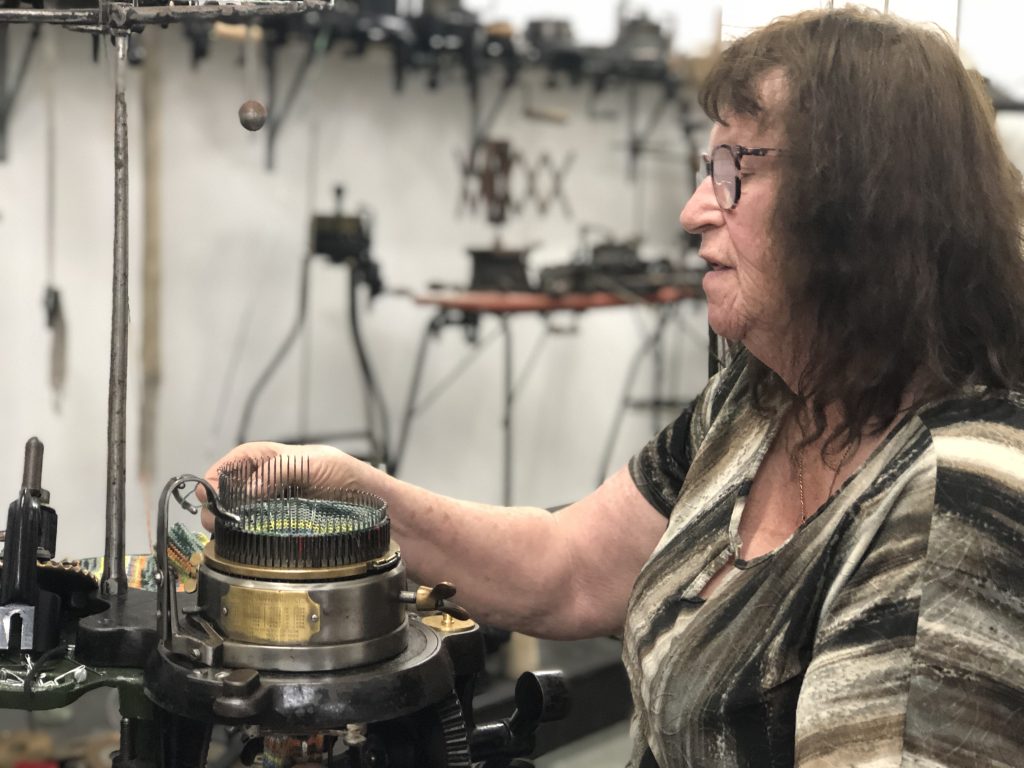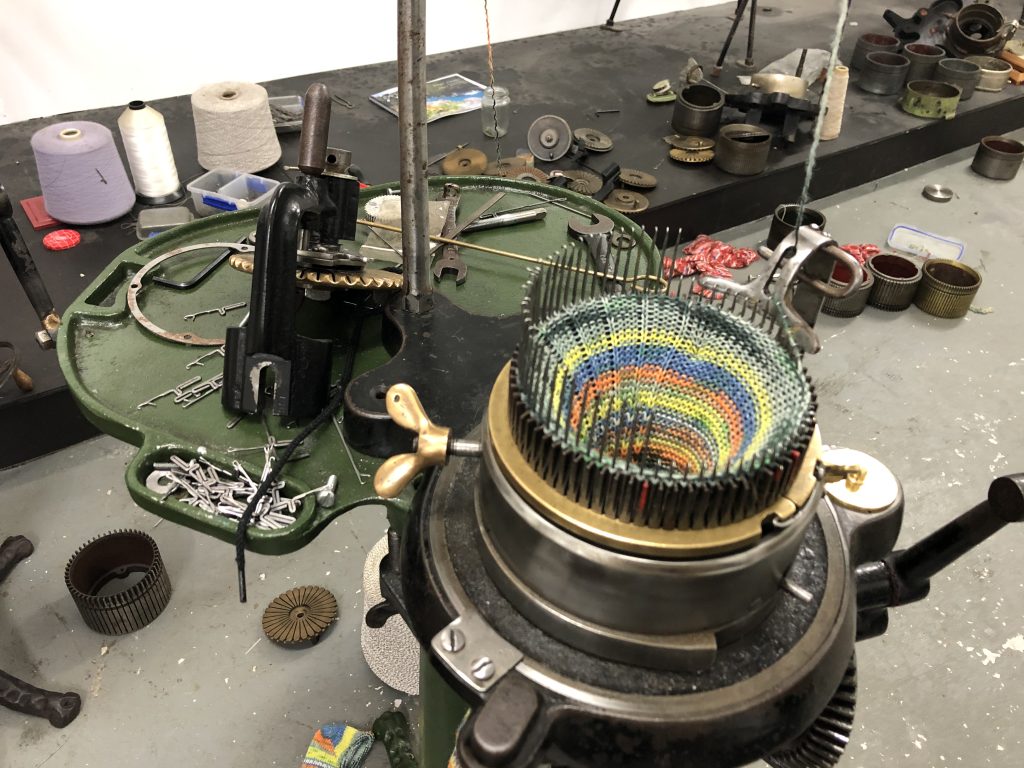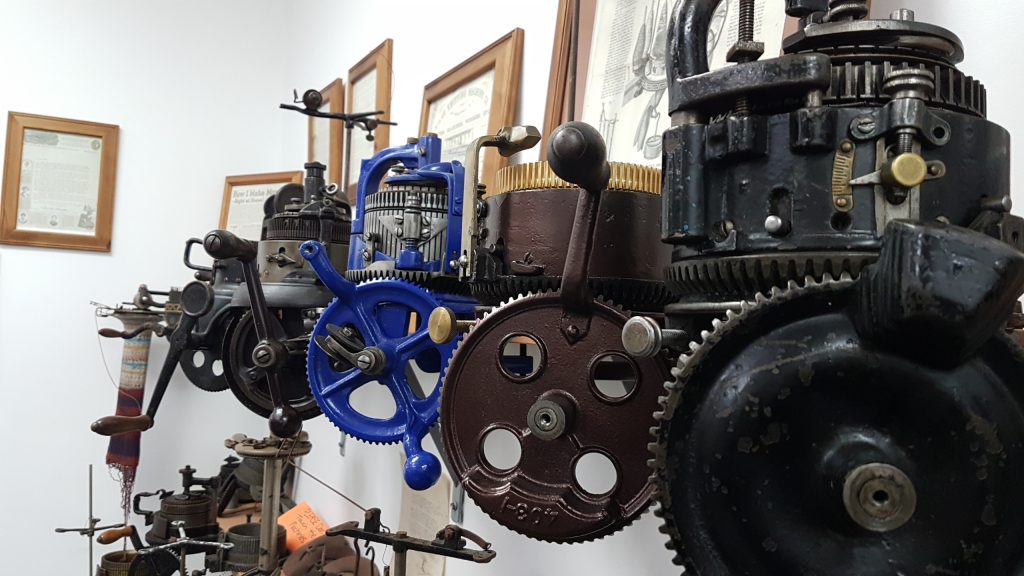Hokitika socks it to the world.
Lurking among the innumerable Facegroups, alongside Genuinely Stoked Goats and the Comic Sans Appreciation Society, there is a 5.5K-member sock knitting community. Not just regular sock knitters. These are Circular Sock Machine knitters, also known as crankers. Conversation centres around yarn tension and brass cylinders, and images show an array of lovingly-oiled machines lovingly cranking out colourful socks, as if electricity were never invented, and as if this were a good thing.
This global sock knitting fanbase has several epicentres, and one of these happens to be on the West Coast of the South Island. Unlikely as it may be, Sock World in Hokitika is at the leading edge when it comes to old-school sock making. It attracts enthusiasts from all over the world, and, according to owner Jacquie Grant, if you’re a sock person, Hokitika is the place to be.
Behind its Vegas-style shop sign, Sock World greets visitors with a colourful array of yarns, socks and homemade dyes, as one might expect from such an establishment. But out the back, past the veil of assorted hosiery, lies a gleaming collection of Circular Sock Machines, from ancient to newly-assembled. There are cogs and needles and other complicated looking bits, reminiscent of Caractacus Potts’ kitchen in Chitty Chitty Bang Bang.

On a screen that towers over this mysterious museum of Circular Sock Machines (which we’ll call CSMs) is Jacqui herself, giving instructions on how to use them. By all measures, she is a sock machine guru, though she’s not into flattery. At the very least, she is a highly-esteemed cranker, and much loved in the sock knitting world. As well as collecting and restoring CSMs, the oldest of which is 120 years old, Jacquie actually builds them.
“I make those to get out of holding peoples’ hands through their first pair,” she says, waving at the instructional video. “I don’t teach people in store if I can help it, I’m a grumpy old thing.” Perhaps, but she’s kind enough to design machines that are easy to use, unlike many of those dating to the 1800s, or older. In fact, you can bet your favourite pair of socks that the first machine in the 1500s would have been a proper head scratcher. On that note, now seems like a good time for a quick history lesson.
The story (well, one of them) goes that a young lad named William Lee, a clergyman in 16th-century Britain, fell in love with a lass who was always knitting. She was so busy knitting socks and stockings and other clothes that she had no time for him, so in 1589 he invented a knitting machine. Whether this relieved her of a chore or an escape plan, we’ll never know.
Lee’s Stocking Frame Knitting Machine mimicked handknitting, back and forth. The design remained constant until a couple of hundred years later, during the Industrial Revolution, when these machines really came into their own. They were brought into factories, and soon after that, made circular, allowing knitters to knit in a tube shape. The mighty Circular Sock Machine was born.
Come World War I, these machines had a big part to play; a pair of dry socks could mean life or death in the trenches, with soggy feet potentially leading to trench foot and amputation. The home front of the allied nations went into action. The cover of Her Excellency’s Knitting Book by Lady Annette Foljambe (1915), sums up this mindset: “For the empire and for freedom, we all must do our bit; the men go forth to battle, the women wait – and knit.”
Until then, most people would have hand-knitted socks, but wartime urgency saw CSMs distributed to homes or lined up in knitting centres, with women at the ready. A machine could produce a pair in just 40 minutes at the hands of an experienced knitter, as opposed to the week of labour that hand-knitting required.

As for Jacquie, her love is for the machines, not the cranking. “It’s quite funny because I was fixing them, restoring them, making parts for maybe eight years before I ever actually knitted a sock,” she says. “I never felt the need. But we do sell a shitload of socks.” The shopfront is mostly a side-hustle, and somewhere to put what gets made; she’s really in it for the nuts and bolts. She’s good with them too, making and selling about 100 machines a year, which she ships around the world.
Jacquie first started playing with CSMs about 30 years ago, and probably knows more about them than anyone in the game. So what on earth led her to socks? The short story: she found an old machine once and made a career out of it. The (slightly) longer? After stumbling across an old knitting machine while running a zoo and making handspun sweaters in Moana, Jacquie began hunting for the right needles to get the thing going.
She put a call out on Radio Pacific (the online marketplace of the eighties), and managed to find an old couple in their nineties who had knitted socks for soldiers in the war. “I bundled about fifty foster kids in the back of the wagon and over to Timaru we went,” Jacquie recalls. There, sitting under dust covers, were fifty Griswold sock machines, untouched since the war.
Luckily for Jacquie, the internet was just becoming a thing, and through the magic of Yahoo chat groups, she was able to get in touch with crankers in the US. “None of us could get parts for these old machines. I thought I could just get these made – the Americans seemed to be pretty bloody dim when it came to that sort of thing.”
So she trudged around the engineering shops of the South Island, searching for someone to help. She was about ready to give up when she found Damian, an engineer who lent his expertise to the project. With him on board, she became the first person in the world to make her own machines since the sixties, and has been doing it for the last 25 years. According to Jacquie, they’ve evolved through about six models now to become completely her own design.

These days, there are other CSM copycats popping up around the world. Of course, there are also large-scale commercial sock machines with programmable computers which can make socks from just about anything, but that’s a whole different ball game.
As for the folks who buy the machines, Jacquie says she gets all sorts, with the key variable being their ability to focus. “I’ve got some who’ve never touched a knitting machine in their lives and within a day they’re knitting socks, good as gold. But some people will never get it; it wouldn’t matter how many times you sat with them, they’ve got the attention span of a gnat.”
GEORGIA MERTON

